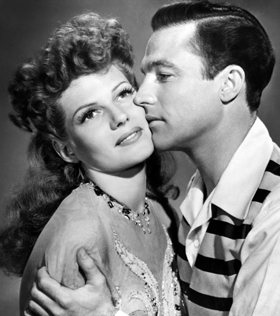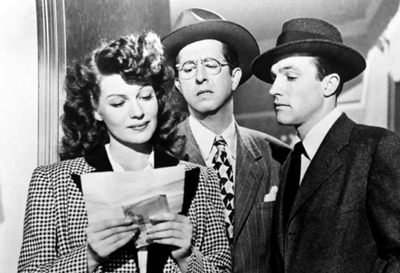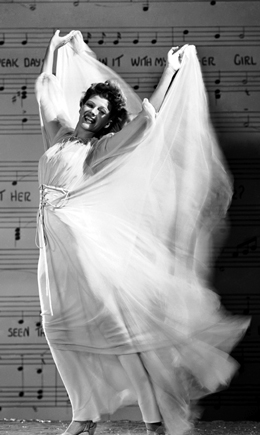
 |
|
|
|
With the exception of work done by Frank Capra and a few others, Columbia Pictures before 1950 wasn't noted for many top pictures in any field, and especially not musicals. So it's interesting that the 'mature' MGM musical would be born not in Culver City, but up at Gower Gulch under the vulgar thumb of Harry Cohn. MGM's Gene Kelly was loaned out to The Torch Lady to co-star with Cohn's top-draw sex bomb Rita Hayworth. Kelly took the creative young director Stanley Donen with him, and made Cover Girl a colorful musical with a standout experimental number. 
The story is pure showbiz corn. Redheaded showgirl Rusty Parker (Rita Hayworth) auditions for a big part in a Manhattan revue, and despite sabotage by jealous competitors, gets it. Auditioner Cornelia 'Stonewall' Jackson (Eve Arden) is perplexed until she finds out why: owner John Coudair (Otto Kruger) sees in Rusty the vision of a showgirl he was forced to give up 40 years before. Rusty grabs at the opportunity, which breaks up her unofficial partnership with Danny McGuire (Gene Kelly) at his humble Brooklyn club. Various rivalries and bitterness set in despite the efforts of funnyman 'Genius' (Phil Silvers) to keep the trio together. Genius and Danny fold the club to go entertain troops. Will Rusty and Danny get together again? On paper Cover Girl must have looked like an MGM knockoff. With moderately good direction from Charles Vidor and solid casting, it's an entertaining vehicle for the devastating woo-bait pinup girl Hayworth, then the most popular star with the nation's fighting forces. Eve Arden and dependable Phil Silvers provide contrasting comic support for the two romantic leads, who spend much of the film with unhappy looks on their faces. Hayworth is well served by a script that give special emphasis to her character. She plays a double roll as her own grandmother, in flashbacks that explain Otto Kruger's strange infatuation. The story is predictable to a fault. Girl gets opportunity, boy gets jealous, they break up, girl almost marries rich jerk, but not quite. In between are some good songs, including the killer standard Long Ago and Far Away, which luckily did not get tapped for the Star Wars franchise. In the tradition of backstage musicals from any studio, showgirl montages and cattle calls provide Technicolor opportunities to fill the screen with glamorous views of a dozen of the year's top models. 
As explained in Robert Trachtenberg's thoughtful docu Gene Kelly: Anatomy of a Dancer, Kelly quickly became disillusioned with his Selznick contract and subsequent servitude to MGM. He had ideas and ambition, but was instead shoved into ordinary roles and bartered off to other studios as a hand-holder for female stars like Deanna Durbin. He rather subversively smuggled his partner in progressive musical thinking, Stanley Donen, into Cover Girl. With the help of what must have been a sympathetic Columbia crew, they created a special number around Kelly's one solo song, Alter Ego. Some of the Jerome Kern / Ira Gershwin musical numbers in Cover Girl are fairly straightforward, the most elaborate being a flashy but unimaginative Ziegfeld-like piece. Rita Hayworth's ony contribution to that glitzy vision is to gazelle down a 50-foot tower, trailing veils in her wake. But other numbers advance the story's character relationships. Alter Ego begins with Gene just walking along the street, conflicted over his love life. In a technical effort that matches any of the clever musical tricks being done at MGM, Kelly's reflection in a store window leaps down onto the sidewalk, allowing him to dance with a phantom version of himself. To put two Kellys side-by-side, the giant Technicolor camera pans and dips and moves in almost complete precision for two separate passes for each shot. When superimposed over the first take, the phantom Gene stays in almost perfect alignment with Gene #1. The result is the kind of analog triumph that's much easier to appreciate than modern CGI effects. Today, a top compositor could duplicate Gene and double him up digitally with little fuss - but where would the craft be in that? 
MGM played catch-up with Columbia when Gene returned, by having him dance with an animated Jerry Mouse in Anchors Aweigh, a film with a script even less inspired than Cover Girl's. But Kelly's experiment with self-choreographing his dance scenes paid off. A couple of years later he and Stanley Donen were happily pushing the musical in different stylistic and technically challenging directions. Not a great deal of chemistry develops between the leads, and the story just kind of ambles to a finish, yet Cover Girl's good reputation rests comfortably on Hayworth's glamour and Kelly's (and Donen's) vision. Hayworth hasn't quite reached the career peak she'd find in Gilda (with director Vidor once again in command), but she certainly turns heads in Technicolor. The Twilight Time Blu-ray of Cover Girl is going to thrill lovers of Golden Age musicals, as Sony's restoration department has provided an HD transfer with super-saturated colors that accurately reflect the original Technicolor look. New digital restoration work has eliminated almost all of the color fluctuation seen in earlier DVD releases. Correct me if I'm wrong -- is the first Twilight Time disc without a separate Isolated Music Track? Twilight Time's insert pamphlet is loaded with color images that prove that Rita Hayworth's image as a pin-up girl was a powerful cultural force in 1944. Julie Kirgo's liner notes relate the sensitivity of the musical numbers to Kelly and Donen's desire to steer musicals in a new direction. She also reflects on Ms. Hayworth, whose career and personal life were then at a happy high point.
On a scale of Excellent, Good, Fair, and Poor,
Cover Girl Blu-ray rates:
Reviews on the Savant main site have additional credits information and are often updated and annotated with reader input and graphics. Also, don't forget the 2011 Savant Wish List. T'was Ever Thus.
Review Staff | About DVD Talk | Newsletter Subscribe | Join DVD Talk Forum |
| ||||||||||||||||||